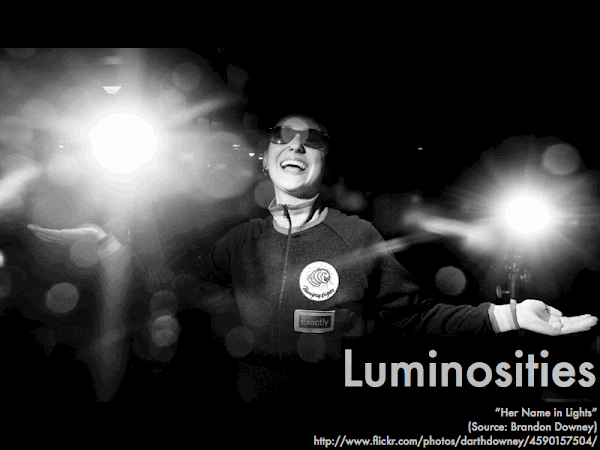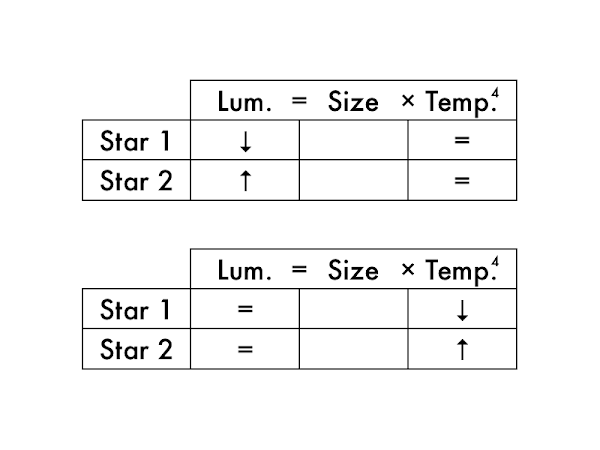Cuesta College, San Luis Obispo, CA
Students have a weekly online reading assignment (hosted by SurveyMonkey.com), where they answer questions based on reading their textbook, material covered in previous lectures, opinion questions, and/or asking (anonymous) questions or making (anonymous) comments. Full credit is given for completing the online reading assignment before next week's lecture, regardless if whether their answers are correct/incorrect. Selected results/questions/comments are addressed by the instructor at the start of the following lecture.
The following questions were asked on reading textbook chapters and previewing presentations on parallax, distance, apparent magnitude, absolute magnitude, Wien's law and the Stefan-Boltzmann law.

Selected/edited responses are given below.
Describe something you found interesting from the assigned textbook reading or presentation preview, and explain why this was personally interesting for you.
"That blue stars are hot and red stars are cold. You would think it would be the other way around"
"I knew there were different colored stars but I didn't realize that white stars are cooler than blue stars. I was going off of flame hotness."
"I like the way astronomers measure luminosity how they 'level the playing field' in a way by taking the stars in comparison and placing them equal distances away and not just going off of the apparent brightness from Earth. This is interesting to me because it make one have to step back and remember that all that is seen from Earth is not all reality and we are much smaller than we presume ourselves to be."
"This chapter wasn't particularly interesting. Or it isn't yet because its too hard to understand and so it makes me mad and not interested at all. wtf"
Describe something you found confusing from the assigned textbook reading or presentation preview, and explain why this was personally confusing for you.
"I was a bit confused about how to determine size of a star even with the other data known."
"I am very confusing about what the heck parsecs are."
"I am not totally familiar with the Hertzprung-Russell diagram. This is my first time ever hearing about it."
"wtf is going on in this chapter. I thought we were at a community college, not Harvard. I like this class a lot and was going to major in astrophysics but not I'm having second thoughts."
Explain how apparent magnitude and the absolute magnitude are defined differently.
How bright a star or any other celestial body looks in space is measured by something called apparent magnitude. The absolute magnitude of an object, such as a star, equals how bright that object would look if it were 10 parsecs, or 32.6 light years away from Earth."
"Apparent magnitude is what you 'think' you see. Absolute is the 'scientific' seeing."
Suppose the sun was moved to a distance of 10 parsecs away. As a result, its __________ magnitude would become dimmer.
absolute. ************* [13] apparent. ************************ [24] (Both of the above choices.) ** [2] (Neither of the above choices.) [0] (Unsure/guessing/lost/help!) * [1]

(Only correct responses shown.)
1 (brightest): the sun, m = -27 [90%]
2: Canopus, m = –1 [78%]
3: Vega, m = 0 [85%]
4 (dimmest): Kapteyn's star, m = +9 [88%]
Rank the brightnesses of these stars (1 = brightest, 4 = dimmest; there are no ties), if relocated to 10 parsecs from Earth.
(Only correct responses shown.)
1 (brightest): Canopus, M = -3 [68%]
2: Vega, M = +0.5 [70%]
3: the sun, M = +5 [65%]
4 (dimmest): Kapteyn's star, M = +11 [78%]
Determine the stars that get dimmer or brighter when relocated from their original positions to 10 parsecs from Earth.
(Only correct responses shown.)
The sun: gets dimmer [78%]
Canopus: gets brighter [64%]
Vega: gets dimmer [58%]
Kapteyn's star: gets dimmer [52%]
Rank the temperatures of these main sequence stars (1 = hottest, 4 = coolest; there are no ties).
(Only correct responses shown.)
Hottest: blue main sequence star [75%]
Second hottest: white main sequence star [60%]
Third hottest: yellow main sequence star [63%]
Coolest: red main sequence star [78%]
Rank the temperatures of these supergiant and dwarf stars (1 = hottest, 4 = coolest; there are no ties).
(Only correct responses shown.)
Hottest: blue supergiant [70%]
Second hottest: white dwarf [58%]
Third hottest: yellow supergiant [65%]
Coolest: red dwarf [75%]

dimmer. **** [4] brighter. *********************************** [35] (These stars would be the same size.) [0] (Unsure/guessing/lost/help!) * [1]
Two stars (equally far away) have the same brightness, but one star is cooler, and the other star is hotter. The __________ star will be larger in size.
cooler. ********************* [21] hotter. *********** [11] (These stars would be the same size.) ****** [6] (Unsure/guessing/lost/help!) ** [2]
Ask the instructor an anonymous question, or make a comment. Selected questions/comments may be discussed in class.
"Would you please make it known to me that you are actually reading my questions?" (Well, I can't guarantee that I actually read your question, but at the very least I cut-and-pasted your question here.)
"I remember a lot of these concepts from the pre-test we took the first day of class and it's making me feel smarter." (Better yet, let's see how much of this you retain for the post-test on these concepts.)
"I could definitely use some clarification of parallax and measuring distance in class."
"I don't really have a question, but I'm watching a 'star' low in the northwestern horizon that is very bright to see if it moves against the rest of the sky gradually, to see if it's possibly a planet! Have to go check on that now."
"How do you feel that we as a class are doing?" (You could all make happier. But that's just me.)
"Why do you love astronomy?" (Who doesn't love the stars? Or better yet, being able to teach about the stars.)
"What is the launch vehicle for the James Webb Space Telescope, and why did they choose it? (The Ariane 5, the very best rocket the European Space Agency has to offer.)
No comments:
Post a Comment